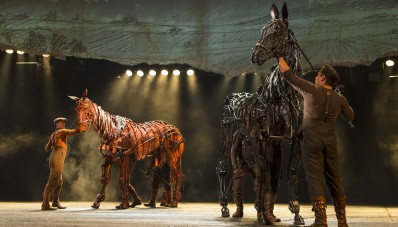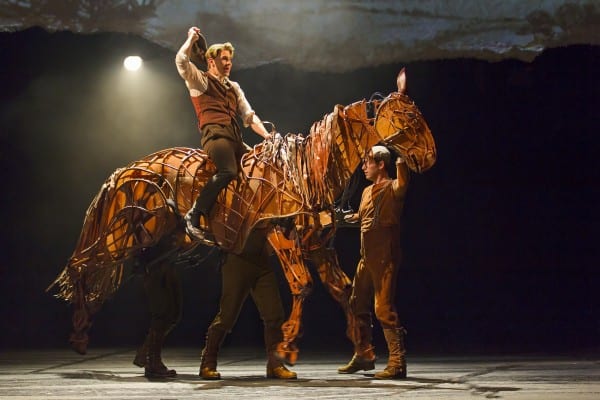 It would be impossible to spend more than 20 minutes sitting in the audience of War Horse, now at the Winspear, and not be bowled over by its excellent stagecraft. Of course, there are the celebrated life-sized puppets — not just of full-grown horses, but of foals and birds. But you can see a puppet show at any state fair midway. What makes War Horse special is the evocative way those creatures are presented.
It would be impossible to spend more than 20 minutes sitting in the audience of War Horse, now at the Winspear, and not be bowled over by its excellent stagecraft. Of course, there are the celebrated life-sized puppets — not just of full-grown horses, but of foals and birds. But you can see a puppet show at any state fair midway. What makes War Horse special is the evocative way those creatures are presented.
The (for want of a better word) protagonist — the title Thoroughbred mutt Joey — is made of a pinkish metal exo-skeleton whose mechanisms (including the three actors who manipulate him) are clearly visible at all time. Plainly, as Rene Magritte might observe, “This is not a horse.” And yet for two-and-a-half hours, you believe it to be one. The first time Joey’s master, the young farmboy Albert, living in Devon, England, at the outbreak of The Great War, strokes his muzzle, you can sense the horseflesh under his hand, the warmth and force of Joey’s breath. In movies, to convince an audience of a horse storming through the fields of France, you need expensive CGI effects; onstage, you just need your imagination.
And lighting. Very, very good lighting.
There’s no denying that War Horse is a spectacle, something uniquely, wonderfully meant for the stage. Even the goose Zoey, who quacks along like a lawnmower with a wry sense of humor, has the personality of a Disney character. Not only have the directors (Bijan Sheibani, after the original work of Marianne Elliott and Tom Morris) conjured in inventive and theatrical ways the life blood of a horse, but also the landscape of war. (The lighting, the puppetry design and the movement are essential as well.) The moment Albert leaps onto Joey’s back and slowly, dreamily gallops off-stage, you will be awed.
The problem is, all this stagecraft rattles around in a poorly constructed play that drags along quite a bit and doesn’t come close to capturing the simple elegance of the book.
Michael Morpurgo’s 30-year-old young adult novel is a quick read, written entirely from the point of view of Joey. We see and hear what Joey does, and we experience the war from the perspective of an innocent. The horrors of the war are real, because an animal is apolitical — he doesn’t side with the Germans or the Brits or the French, but with his own survival. When Joey is outside the earshot of humans — as he spends most of the story away from Albert — we are as in the dark as he is about what’s really going on.
The adaptor, Nick Stafford, seemed uncomfortable with identifying with a quadruped, and hangs his narrative not on the horse, but on Albert’s desire to find him. We spend countless scenes (no where in the book) back home with Albert on the farm, desperate to recover his beloved steed … as if an audience wouldn’t otherwise believe the reunion of boy and pet. Joey becomes a plot device more than an individual. We don’t experience his emotions at all.
 A key relationship in the book, for instance, is actually between Joey and his larger war companion Topthorn, a massive Thoroughbred built for war; their connection drives the second half fo the book. Topthorn seems little more window dressing in the stage version.
A key relationship in the book, for instance, is actually between Joey and his larger war companion Topthorn, a massive Thoroughbred built for war; their connection drives the second half fo the book. Topthorn seems little more window dressing in the stage version.
Perhaps complaining about the lack of psychological motivation of a horse seems a petty way to discuss a story. But War Horse is far more spectacular than it is simply good. It suffers from many of the weaknesses of the film version (which was based on the play), and some more, including a sloggy pace in some scenes and several unconvincing performances (Albert looks way too old to pass for 16, and the actress playing his mother is no more convincingly British than Madonna tries to be.)
Still, it would be difficult not to recommend it if only because the system of its storytelling can be phenomenal. Even the Irish troubadour, wandering through scenes narrating them musically like the band on Monty Python and the Holy Grail is a nice touch. When it startles you with its beauty, you will be touched. If only it could sustain that beauty and not drag on longer than anyone wants. You’d think they’d have learned that from World War I.

